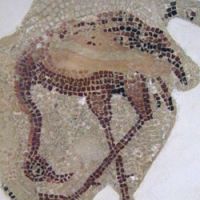Regular readers know that my usual sphere is the biosphere and that I typically pursue wildlife in the wilds. Occasionally, though, one should step beyond home turf and try dipping a toe into a new stream of consciousness.
Such was my good fortune last month when an extraordinary opportunity arose to participate in a journey by ship along the Mediterranean shores of North Africa, and not only to travel but to explore ancient archaeological sites in the company of specialists in the field of antiquities. Our goals were to visit the North African Roman-era sites of Tipasa, Djemila and Hippo Regius in Algeria, and El Jemm and Dougga in Tunisia, along with the Punic remnants of Carthage. If you think that as a naturalist I felt out of place, you are correct. Nevertheless, my natural history interests were by no means wasted, and my childhood interests in ancient history were soon rekindled on seeing the extraordinary remains of past civilizations to be found in North Africa.
For pure scenic pleasure, combined with stunning remains, Tunisia's Dougga can hardly be beaten. The ancient site, with its fabulous theater and capitol, crowns a hilltop 550 meters above sea level, commanding views over hillsides dotted with venerably aged olive trees and field after field of waving wheat probably barely changed in 2,000 years. Flowers were bursting into bloom everywhere; there were carpets of red poppies beneath olive and almond groves, deep yellow crown daisies among the green of tall grasses, and blue heads of viper's bugloss nodded gently on the spring zephyrs. A Moussier's redstart, resplendent in burned orange, black and white, sang from atop a tall stone column, while migrant European bee eaters, returning north to breed, called softly as they passed high overhead.
With regard to size, the great remains at Djemila in Algeria, rival those of Dougga. The journey there, by way of the rugged Kherrata gorge between the Mediterranean coast and the high plateau of the Tellian Atlas mountains, was all the more dramatic, enhanced by encounters with Barbary macaques along the crags and nesting European white storks in massive treetop nests along the broad, open valley near Setif.
An archaeologist might argue that Djemila is the more outstanding of these two sites, and who would I be to argue with them; the remains are breathtaking. Had I been alive all those centuries ago, however, I would have chosen Tipasa as the place to call my home. That ancient town, in modern Algeria, sits atop a low cliff with a stunning view to the sea. The ever-present sound of the waves would have been a backdrop to daily life there.
In Algeria, binoculars are treated as military equipment and so are banned. Not able to carry my binoculars (usually ever present around my neck), I felt like a microbiologist deprived of a microscope or a golfer with no clubs. So at each site I sought out the quiet corners, enjoying the wildflowers encrusting aging pavements, sending tendrils of fine roots into crevices between ancient masonry, affording — depending on the species — dashes, hints and splashes of color to the muted shades of the old lichen-coated stones. I learned once again the pleasure of focusing on sound. I listened intently as corn buntings and Sardinian warblers scratched out their simple refrains from thorny maquis shrubs around the sites, and as European nightingales throbbed out their sweet, pulsing songs from dense cover. I noted an already occupied northern raven's nest in a graceful angle of stonework that dated back at least 1,600 years, while pallid swifts hurtled overhead screaming their own shrill version of a love song as they sought rock crevices in which to nest. I focused my attention instead on elements of the natural world I might normally have missed: a praying mantis here, a wall lizard there and flittering blue butterflies across the bright pattern of wildflowers.
Unexpectedly, my greatest wildlife experience in North Africa came not outside, but indoors in the famed Bardo Museum in Tunis. There, one steps straight onto an extraordinary legacy of the Roman period — mosaics. As if carpeted and tapestried, the floors and walls of many of the rooms of the Bardo Palace buildings are covered with mosaics. I was unprepared for the vibrancy of the colors and the extraordinary scope of the scenes depicted. I had imagined, and was not disappointed by, scenes of the pantheon of gods and of daily life, but I was not expecting the extent of the hunting and fishing scenes, nor the detail of the local mammals, birds and fish. My challenge, on finding this wealth of illustrative material in tiny stonework patterns, was to see how many species I could identify within the mosaics themselves. Binoculars or no binoculars, I was immediately hooked.
One must bear in mind that the fauna of the region has changed over the millenniums (as savanna and forest have given way to drier grasslands and agriculture), and furthermore that under the influence of Rome, wild creatures from further afield were traded and introduced either into the arena for spectator sports or into the wild for hunting. Among the mosaics, I quickly found lions, leopards and even tigers. Hyenas, giraffes, wild boar, bears, hares and even hedgehogs were depicted, as were a wealth of fish and birds. Marine life included dolphins, rays, rockfish, octopus, squid and even sea urchins and whelks. The birds presented some of the easiest and also some of the greatest identification challenges. I wondered if perhaps the original mosaicists were equally challenged. Common crane, greater flamingo, Barbary partridge and ostrich were all readily classified. Ring-necked pheasant, ring-necked parakeet and peacock, along with frequent depictions of tigers, all referred to introduced species from South Asia and were easily distinguished, but the size of each tile, though small enough to suit most illustrations, left something to be desired for the birds. Deprived of their natural postures and behaviors by ignorant mosaicists, and limited in the detail of their coloration, recognizing them was not always possible, though it was always an interesting challenge. I located mallard and moorhen, guinea fowl, Egyptian goose, little owl and collared dove, among a surprising array of species, but finding a bee eater, and then a hoopoe, provided the greatest thrills, particularly in conjunction with sightings of the flesh and blood versions at Dougga and Carthage.
That ancient mosaicists were aware not only of the colors of their subjects but also of the nature of those colors was a revelation; judicious use of green glass to indicate the metallic sheen on a peacock's tail or in a mallard's plumage indicated the extent of their attention to detail.
Other mosaics revealed a clear vision of how mammals such as horses and dogs move, but for sheer whimsy it was impossible to beat the artistic mosaic representation of ostentation in the form of a tiger-skin rug!
Mark Brazil, a naturalist and author with a fascination for life in all its forms and the questions that it raises, leads naturalists around the world for Zegrahm and Eco-Expeditions. His first book "A Birdwatcher's Guide to Japan" is out of print, but Mark has some mint-condition signed copies available for sale. [email protected]






